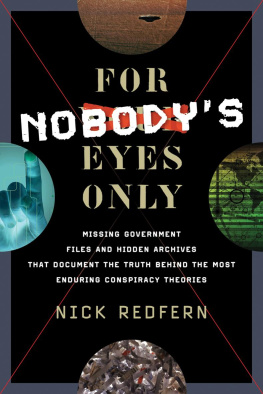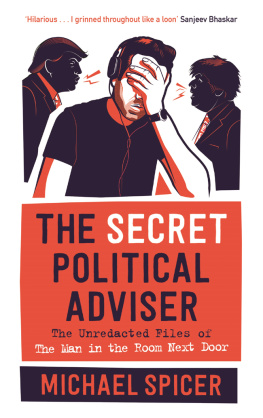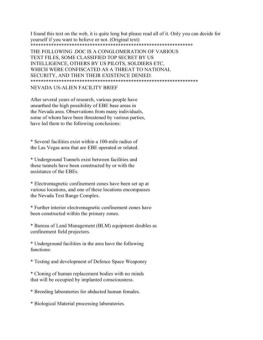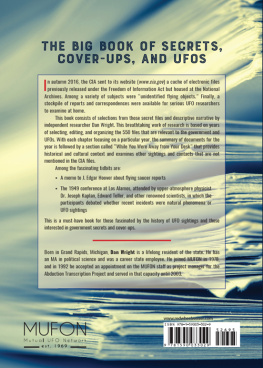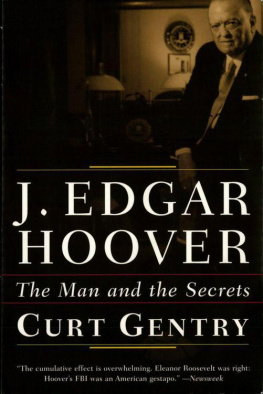From the Secret Files of
J. Edgar Hoover
BY THE SAME AUTHOR
The Boss: J. Edgar Hoover and the Great American Inquisition
Beyond the Hiss Case
Spying on Americans
The Specter
Seeds of Repression
The Yalta Myths
Anatomy of Anti-Communism
From the
Secret Files of
J. Edgar Hoover

EDITED WITH COMMENTARY BY
ATHAN THEOHARIS


FROM THE SECRET FILES OF J. EDGAR HOOVER. Copyright 1991, 1993 by Athan Theoharis. This book was originally published in 1991 by Ivan R. Dee, Inc. This paperback edition contains a new Appendix on Secret Files, Secret Records Systems.
First ELEPHANT PAPERBACK edition published 1993 by Ivan R. Dee, Inc., 1332 North Halsted Street, Chicago 60622. Manufactured in the United States of America and printed on acid-free paper.
Library of Congress Cataloging-in-Publication Data:
Theoharis, Athan G.
From the secret files of J. Edgar Hoover / edited with commentary by Athan Theoharis.
p. cm.
Elephant paperbacks.
Includes index.
ISBN 1-56663-017-7 (acid-free paper)
1. Internal securityUnited StatesHistory20th century. 2. Anti-communist movementsUnited StatesHistory20th century. 3. Subversive activitiesUnited StatesHistory20th century. 4. Hoover, J. Edgar (John Edgar), 18951972Archives. 5. United States. Federal Bureau of InvestigationArchives. I. Title.
[E743.5.T48 1993]
353.0074dc20
92-41197
For Nancy, Jeanne, George, and Elizabeth
their commitment to peace and social justice
inspire and justify this effort
Acknowledgments
I have incurred a number of debtsfinancial, research, and editorialin compiling this book of documents. I could not have defrayed the substantial costs required to obtain FBI documents under the Freedom of Information Act without the financial assistance of the Field Foundation, Warsh-Mott Funds, C. S. Fund, Fund for Investigative Journalism, Webster Woodmansee Fund, and Marquette University. I am indebted to numerous individuals who shared their research findings with me, including Kenneth OReilly, Stephen Leahy, Chris Span, Seth Rosenfeld, Alex Charns, Jim Rowen, Tony Mauro, and Laura Kalman. The staff of the FBIs Records Management Division, and particularly its chief Emil Moschella, processed my numerous FOIA requests with dispatch and a high degree of professionalism. At a critical time Judy Klawitter provided invaluable typing assistance while Jeffrey Shulman and John Muscato offered helpful editorial direction at the initial stage of this project. I am particularly indebted to my editor, Ivan R. Dee, whose demanding editorial criticisms and suggestions made this a better book. I can never fully acknowledge the support of my wife, Nancy, and my children, Jeanne, George, and Elizabeth. Not sharing my compulsivethey would claim obsessiveinterest in the FBI (as well as Marquette basketball and their soccer playing), they forced me to adopt a more balanced perspective. Their principled commitment to a more just social order has inspired my own work.
A. T.
Contents
The Inga Arvad AffairBriefing Memo on Democratic Presidential Nominee KennedyMemo re Transfer of Arvad Folder to Hoovers OfficeOther Kennedy Affairs
The El Paso AffairThe Marilyn Monroe Affair
Monitoring the Candidate, Then the PresidentThe Kay Summersby Affair
The Joseph Lash Affair and Its UsesAmerican Youth Congress Break-in
Allegations of Homosexuality, Affairs, Consorting with Prostitutes, and Alcoholism Among Members of Congress, White House Aides and Guests, and Governors
Summary Memo ProcedureHenry Cabot Lodge, Jr.George McGovernWilliam AndersonClaude PepperFBI Arrangement with House Appropriations Committee
Federal EmployeesLabor UnionsUniversitiesCivil Rights GroupsMartin Luther King, Jr.Educational Program and Dissemination to MediaCovert Assistance to HUAC During Hollywood HearingsRonald Reagan as InformerDissemination Programs: Governors, Herbert Hoover, Congressional CommitteesDissemination to Presidents Johnson and Nixon
Advance Planning to Avoid DiscoveryDo Not File Procedure
Roosevelts Wiretapping DirectiveTrumans Wiretapping LetterMcGraths Memo on Wiretapping and BuggingBrownells Bugging PolicyKennedys Bugging PolicyJohnsons Wiretapping and Bugging Policy
Hoovers AuthorizationJustice Department Decision to Brief the Supreme CourtFBI Briefings to Senator Edward LongConflict with Justice Department over Response to the CourtFBI Briefings to Johnson White HouseFBI Media AssistancePost-Court Strategy
1936 Meeting with Roosevelt1939 Roosevelt DirectiveJacksons Rules for FBI InvestigationsForeign Intelligence RoleForeign Liaison Expansion
President Franklin RooseveltPresident Harry TrumanRepublican Presidential Candidate Thomas DeweySenator, Vice President, and President Lyndon JohnsonDemocratic Presidential Candidate Hubert HumphreyPresident Richard Nixon
Cover-up of Assistance to McCarthyDecision to Sever Relations
Monitoring the Supreme CourtMonitoring the Federal BureaucracyInformer in the Justice DepartmentInformation on Columnist Drew PearsonMonitoring Washington PersonalitiesAdlai StevensonSex Deviate Program
Policy OriginsContentsLetter re President EisenhowerSharing Information with OSS, CIA
Assistance to Friendly ReportersProposal to Prosecute Chicago TribuneProposal to Investigate Book Publishing and AuthorsAssistance to Senator Robert ByrdColumnist Clayton FritcheyReporter Jack NelsonColumnist Joseph AlsopAssistance to Joseph Kennedy, John D. Rockefeller III, Harry Hopkins, John Mitchell, Warren Burger
Taping of Office CallsVincent Astor and the Kermit Roosevelt MatterMonitoring Senator George NorrisMonitoring Criticisms of HooverProfiting from the FBI DirectorshipMonitoring Allegations of Hoovers Homosexuality
From the Secret Files of
J. Edgar Hoover
Introduction
ATTORNEY GENERAL CHARLES Bonapartes July 1908 order creating a permanent investigation division within the Department of Justice, the Bureau of Investigation (formally renamed the FBI in 1935), marked a new phase in the nations political history. Until then, libertarian and states rights values had defined law enforcement as a local and state responsibility. In 19071908, when Secret Service agents (temporarily hired by the Justice Department) uncovered evidence of land fraud which led to the indictment of two U.S. congressmen, Congress was incensed by this targeting. Members likened the actions to those of a tsarist secret police and voiced fears of a national secret police and its threats to a government of checks and balances. In January 1909, the outgoing attorney general sought to allay these concerns, heightened by his unilateral action in creating the Bureau of Investigation. He denied in congressional testimony that the newly created Bureau would pose any such threat. Bonaparte assured the congressmen that Bureau investigations would be confined to enforcing the antitrust and interstate commerce laws. The Bureau was not about to monitor political dissent or target members of Congress at the request of their partisan adversaries in the White House.
U.S. involvement in World War I in April 1917 proved that the alarmist concerns of 19071908 were prescient. During the period 19171921, Bureau of Investigation agents compiled more than 200,000 dossiers on American organizations and residents (including the pacifist Jane Addams, antiwar Senator Robert LaFollette, civil libertarian Roger Baldwin, and Irish nationalist Eamon de-Valera) because of their opposition to the Woodrow Wilson administrations foreign policy. Agents continued to monitor the activities of radical trade unionists and socialists even after the armistice of November 1918. Lacking the authority to use the acquired information for prosecutive purposes, the Bureau shared it with state police officials and private employers who had an interest in identifying union organizers and activists. The extent of this extralegal and covert assistance acquired a new dimension with the disclosure in 1923 that Bureau agents had monitored those congressional critics of the administration of Warren G. Harding who had exposed the Teapot Dome scandal. This monitoring had included breaking into and wiretapping the offices of these congressmen.
Next page


